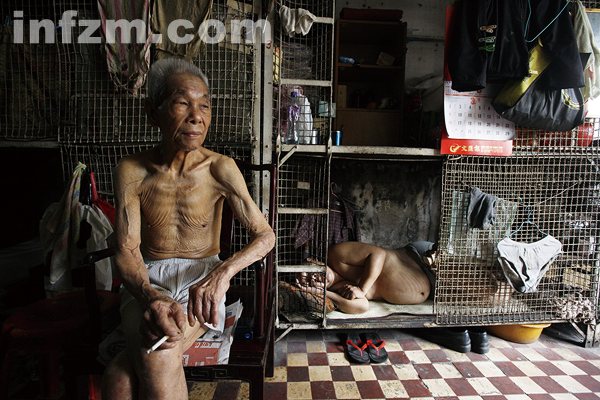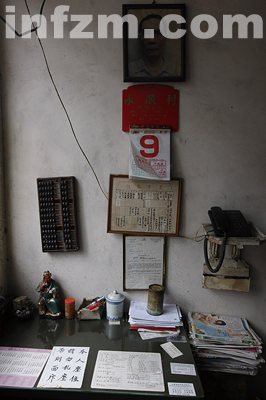Southern Weekend covers the bedspace apartments, or cage homes, in Hong Kong. Translated by CDT:
In the summer of 2009, the air was heavy. Only the creaking of the fan could be heard.
The sour stench of urine mixed with the smell of soaked sweat, filling the air of the 40 to 50 square meter rectangular room. 60-year-old Old Deng leaned against a wall, staring out into space. Just three floors below was a street in Hong Kong’s Mong Kok area. Most here are old residences, neon lights, and a sea of sign boards. They bring back memories of scenes in Hong Kong cop and robber movies, where the good is mixed with the bad.
Inside the residence, against the wall, are 7 double-decked iron beds. In front of each bed is a wire lattice. It’s almost like a metal cage. At the moment, two men were napping inside the “cages.”
Old Deng coughed a few times, and spit. After, he turned and pulled the iron lattice, and then locked it. He had placed a shower gel and detergent inside the “cage,” in the divider. His was the cleanest bed. Others were grimy, some with even small syringes inside.
Old Deng was rail thin and stooped. He slowly strolled out.
“Cage homes” have been a difficult social problem for Hong Kong’s government for years. They are legally known as bedspace apartments. Most renters are the old and enfeebled, Hong Kong’s unemployed, lone independents. They have been called “cage people.” Those concerned about their livelihoods have strongly criticized government policies, and a legislative council member even moved an “iron cage” onto the street, in the hopes of attracting more attention.
Around ten people lived in Old Deng’s place, packed like sardines. Once, after a fire, the government required that two-levels be constructed. Currently, most have already lived here for twenty to thirty years.
“Before, one bed would be 200 kuai in rent per month,” Old Deng said. Every two months, the price would go up, increasing by twenty percent. Now, each month’s rent costs 1200 Hong Kong dollars.
Most “cage people” depend on government payouts. Comprehensive Social Security Assistance totals 2200 Hong Kong dollars; unemployment payment is 1830 HKD. Aside from this, there is also charity aid. Every weekday, a charitable organization provides him with dinner. They have already gotten used to this sort of life.
Hong Kong’s government departments do not simply remove the bedspace apartments. They go through legislative channels to ensure that they meet standards for fire control, hygiene, and building safety. In 1994, Hong Kong published the “Bedspace Apartments Ordinance” in order to improve and reduce the number of “cage homes.” According to records at Hong Kong’s Home Affairs Bureau, there were 30 licensed bedspace apartments and 910 beds. Last year, that number has already decreased to 21 apartments and 775 beds.
“Cage homes aren’t part of the Hong Kong government’s relief program. We’re only hear to check sanitation, to see if fire control meets standards,” explained the information officer for the Home Affairs Bureau.
The rent for Old Deng’s place should normally be 6000-7000 HKD (sic) per month. The landlord hardly ever shows up, and has hired a representative to collect the rent. All of the “cage people” told us: “Don’t take pictures, or else the landlord will get upset.”
After Old Deng left, the residence felt incredibly lonely. 80-year-old Luo Sheng sat by the doorway, complaining about his “bleak [situation],” and how he was lucky to have an older brother in Macau who would send him money whenever he came up a little short.
“I’m old already. One or two of us are renting a place together, and if something happens, no one will know. [But] these are my brothers in the ‘cage’; we look after one another,” said the elderly man. But onlookers might say there isn’t much of a brotherhood to speak among the ‘cage people.’ Bickering and fighting often erupt, and sometimes a person would get slapped in the face over eating someone else’s bowl of food.
Not long ago, due to narcotic use and drug concealment, one of the ‘cage people’ was taken away by police. About a half month later, he came back to the cage home.
In the dark of the night, these ‘cage people’ look like statues as they sit idly. The only sound is the creaking of the fan, and the television’s news report announcement.
For CNN, Eunice Yoon reports on another bedspace apartment complex (also with video):
The 19 occupants share two toilets. A small rubber hose attached to a leaky faucet is what they use to wash themselves. Social workers who monitor the apartments said the electricity is donated, so a few of them have TVs. One person on the upper deck has an aquarium.
One social workers said that because of the recession these homes are being occupied more frequently by those made jobless — people in their 30s and 40s. The social worker said none of the younger people wanted to speak on camera for fear their chances of finding work would be hurt.
Chung, 67, is now waiting for welfare to kick in and is on a long list for public housing. The government says it is doing its best to meet its citizens’ needs, but Chung says he has lost all hope. Economic recovery or not, he feels forgotten.












